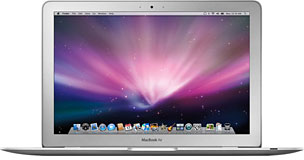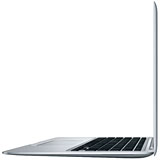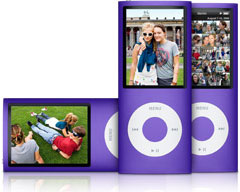Apple surprised everyone by releasing an updated version of the Mac Pro one
week before the MacWorld Expo.
The new model used Intel's 4-core 'Harpertown' CPU, and 8 cores (two
quad-core CPUs) is the default except on the entry-level
configuration.
MacBook Air

The slim, light MacBook Air.
 Getting
the Mac Pro out of the way allowed Apple to focus on its first
Intel-based subportable at the Expo - and the first completely new
model of the Intel Era. The MacBook Air is barely 3/4" thick
and weighs just 3 lb. - that's with a full-sized keyboard and a 13.3"
1280 x 800 display. For the first time since the G3, there's no
built-in optical drive; users can buy an external SuperDrive for $99 or
use special software to "borrow" the hard drive of a nearby Mac or PC
with WiFi.
Getting
the Mac Pro out of the way allowed Apple to focus on its first
Intel-based subportable at the Expo - and the first completely new
model of the Intel Era. The MacBook Air is barely 3/4" thick
and weighs just 3 lb. - that's with a full-sized keyboard and a 13.3"
1280 x 800 display. For the first time since the G3, there's no
built-in optical drive; users can buy an external SuperDrive for $99 or
use special software to "borrow" the hard drive of a nearby Mac or PC
with WiFi.
The MacBook Air has an aluminum unibody enclosure and a black,
backlit keyboard. It has only one I/O port, a USB 2.0 connector hidden
behind a door. It was the first Mac without FireWire since 2001 (the
350 MHz iMac G3).
Other Expo News
Time Capsule was also introduced at the Expo, a WiFi hub and 500 GB
or 1 TB backup drive designed to work in conjunction with the Time
Machine feature in Leopard. Apple also unveiled a completely overhauled
Apple TV - the hardware remained the same, but the software was all
new.
Apple announced five new apps for the iPod touch, which would be
standard on newly built units but cost $20 for those who already owned
this iPod.
More Hardware Updates
In February, Apple updated the MacBook and MacBook Pro lines using
Intel's new Penryn CPU. The new 13.3" MacBook model
came in 2.1 GHz and 2.4 GHz versions. Although the 3 MB L2 cache was
smaller than the one in the previous MacBook, Macworld benchmarks found
that the new models were more powerful than their predecessors.
The 15" MacBook
Pro saw a modest jump in CPU speed from 2.2 and 2.4 GHz to 2.4 and
2.5 GHz. Again, the new Penryn CPU made the new models more powerful
than clock speed alone would indicate, and the 2.5 GHz model had a 6 MB
L2 cache (as did the 2.6 GHz build-to-order option). The updated
17" MacBook
Pro ran at 2.5 GHz, and had a hi-res screen option in addition to a
2.6 GHz option.
Apple introduced a pink iPod in February, just in time for St.
Valentine's Day, and later added a 2 GB iPod shuffle, trimming the
price of the 1 GB model from US$79 to US$49.
Apple moved the iMac
to the Penryn CPU in April, offering a 3.06 GHz build-to-order option
for the 24" model, which also had the option of Nvidia GeForce 8800
graphics, the first time an iMac had a video upgrade option.
iPhone and iPods
On July 11, Apple released the second version of the iPhone, known
as the iPhone 3G (because of its 3G network capabilities). Apple
released version 2.0 of the iPhone/iPod touch version of OS X at the
same time.
The entire iPod line was revised on Sept. 9. The iPod shuffle was
given a new range of colors, and the iPod touch now included version
2.0 firmware and was thinner, topping out at 32 GB. The only change to
the iPod classic was replacing the 80 GB and 160 GB models with a new
120 GB one.
 The iPod
nano was completely redesigned as a thin, slim media player in 8 GB and
16 GB capacities (with a 4 GB version in a few markets). It was
available in 9 different colors.
The iPod
nano was completely redesigned as a thin, slim media player in 8 GB and
16 GB capacities (with a 4 GB version in a few markets). It was
available in 9 different colors.
One of the hot new features was "shake to shuffle", facilitated by
motion sensors. For the first time, new iPods could no longer be
charged with docks that used FireWire. This also impacted some older
third-party devices.
New 'Books
On October 14, after one of the longest periods ever without a new
Mac model, Apple revised its entire notebook line. The top-end 17" MacBook Pro was
bumped to 4 GB of RAM with a 320 GB hard drive. The MacBook Air received its first
update - it gained Nvidia GeForce 9400M graphics and a mini
DisplayPort connector for an external display. The entry level MacBook
was named the "MacBook
White" and reduced in price to $999, and for the first time Apple
put a SuperDrive in its entry-level MacBook.
 The big
changes were new "unibody" designs for the MacBook and 15" MacBook Pro. The
new models were carved from a block of aluminum and used a glass
trackpad, based on the same technology as the iPhone and iPod touch
screens. nVidea GeForce 9400M graphics was standard on both, and
the MacBook Pro also had nVideo GeForce 9600 graphics with
dedicated video RAM, the first time Apple had put two graphics
processors in a notebook computer. (Users could choose the superior
performance of the 9600 or the superior battery life of the 9400M.)
The big
changes were new "unibody" designs for the MacBook and 15" MacBook Pro. The
new models were carved from a block of aluminum and used a glass
trackpad, based on the same technology as the iPhone and iPod touch
screens. nVidea GeForce 9400M graphics was standard on both, and
the MacBook Pro also had nVideo GeForce 9600 graphics with
dedicated video RAM, the first time Apple had put two graphics
processors in a notebook computer. (Users could choose the superior
performance of the 9600 or the superior battery life of the 9400M.)
Along with the MacBook Air, the unibody models all used Apple's new
Mini DisplayPort.
Visually, the new MacBook and MacBook Pro stand out for a black
surround for their glossy displays. Also, there is no longer a separate
mouse button - the entire trackpad surface functions as a button.
Beginning of the End for FireWire?
There was a great uproar on the Mac Web over the loss of FireWire on
the aluminum MacBook, Apple's first notebook (other than the MacBook
Air) without FireWire since the late clamshell iBook era. This meant
there was no way to connect the Unibody MacBook to FireWire-only
devices such as hard drives and older camcorders, and it eliminated
Target Disk Mode, a great tool for moving files between Macs and
running diagnostics.
The new MacBook Pro has a FireWire 800 port, but it no longer has
FireWire 400. Fortunately a simple adapter allows use of FireWire
400 devices with a FireWire 800 port. Just as the iPod had eliminated
FireWire support over the years, it looked like FireWire could be on
the way out on the Macintosh as well.
Unchanged
To the surprise of many, the Mac mini - last updated in August
2007 - remained unchanged. Many hoped to see an upated Mac mini at the
January 2009 Macworld Expo, but it was not to be.
Next: 2009 - in progress


 Getting
the Mac Pro out of the way allowed Apple to focus on its first
Intel-based subportable at the Expo - and the first completely new
model of the Intel Era. The
Getting
the Mac Pro out of the way allowed Apple to focus on its first
Intel-based subportable at the Expo - and the first completely new
model of the Intel Era. The  The iPod
nano was completely redesigned as a thin, slim media player in 8 GB and
16 GB capacities (with a 4 GB version in a few markets). It was
available in 9 different colors.
The iPod
nano was completely redesigned as a thin, slim media player in 8 GB and
16 GB capacities (with a 4 GB version in a few markets). It was
available in 9 different colors. The big
changes were new "unibody" designs for the
The big
changes were new "unibody" designs for the 
